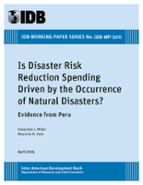Is Disaster Risk Reduction Spending Driven by the Occurrence of Natural Disasters? Evidence from Peru
Date
Apr 2014
This paper studies the allocation of total disaster risk reduction public spending among regions in Peru. The main objective of this work is to identify the main determinants of the distribution of these resources, and for this purpose an index of historical physical impacts of natural disasters, social vulnerability, and institutional capacity was created. It is found that historical impacts of climatological disasters are positively correlated with the per capita amount received by region in order to prevent future natural disasters. Impacts of geological disaster, on the other hand, affect the amount of executed and budgeted resources used to cope with the effects of past disasters. The prevention expenditure is mainly driven by climatological effects on the agriculture sector. Additionally, results confirm that higher social vulnerability is a main determinant of the distribution of prevention spending but conditioned on being affected by climatological disasters. Institutional capacity seems to define only the amount of recovery expenditure, positively for regions more seriously affected by geological disasters and negatively for regions devastated by climatological disasters.



